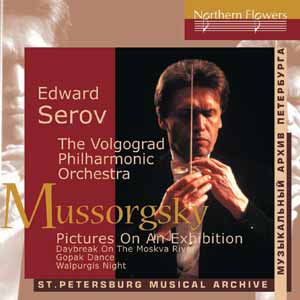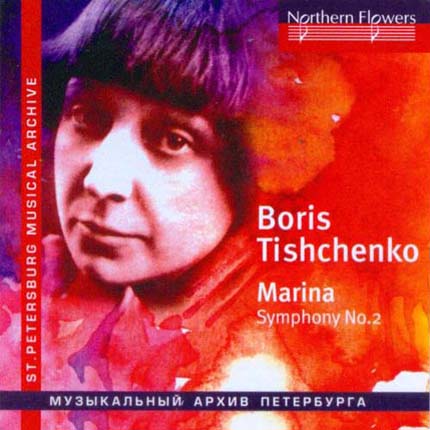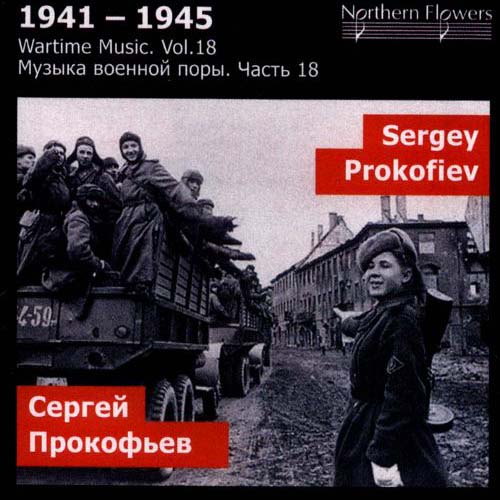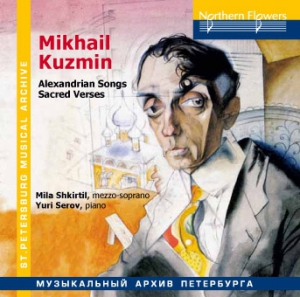Description
M.P. MUSSORGSKY(1839–1881)
Walpurgis Night
Pictures On An Exhibition (arranged by M.Ravel)
Symphonic Fragments from the Operas
Khovanschina
Sorochintsy Fair
The Volgograd Symphony Orchestra
Edward Serov , Conductor
| 1. | Walpurgis Night, a symphonic picture, 1867 Arranged and edited by N. Rimsky–Korsakov |
11.20 |
| 2. | Daybreak On The Moskva River (Introduction to the opera Khovanschina) |
5.23 |
| 3. | Dance Of Persian Girls from the opera Khovanschina Arranged and edited by N. Rimsky–Korsakov |
8.06 |
| 4. | Procession of Prince Golitsyn’s Cortege (Entr’acte to Act 3 of the opera Khovanschina) Arranged and edited by D. Shostakovich |
4.54 |
| 5. | Introduction to the opera Sorochintsy Fair |
5.19 |
| 6. | Gopak Dance from the opera Sorochintsy Fair Arranged and edited by A. Lyadov |
1.55 |
| “Pictures On An Exhibition”, 1874 (arranged by Maurice Ravel in 1922) |
|
|
| 7. | Promenade. A Dwarf |
5.04 |
| 8. | Promenade. An Old Castle |
5.38 |
| 9. | Promenade. The Tuillery Garden |
2.02 |
| 10. | Canaille |
2.50 |
| 11. | Promenade. A Ballet Of Nestlings In Their Eggshells |
2.15 |
| 12. | Two Jews, A Rich And A Poor One |
2.35 |
| 13. | Limoges. Market. (Big News) |
3.43 |
| 14. | The Catacombs. (Roman Tomb). To The Dead In A Dead Tongue |
2.17 |
| 15. | The Hut of Baba Yaga. Paladin’s Gate |
9.46 |
| Total Time |
73.32 |
|
| Recorded in the Central Concert Hall in Volgograd, 1994. Sound Engineer: Semyon Shugal Text: Marina Kolmakova. English text: Sergei Suslov Design: Anastasia Evmenova, Oleg Fakhrutdinov. |
||
|
M.P. MUSSORGSKY: Walpurgis Night, Pictures On An Exhibition (arranged by M. Ravel), Symphonic Fragments from the Operas Khovanschina and Sorochintsy Fair
The proportion of instrumental compositions in the creative heritage of Modest Petrovich Mussorgsky is relatively small. The composer’s predominant interest was in music related in such or another way to word and drama: opera, songs, vocal chains. Even his only large symphonic piece Walpurgis Night (lit. “St. John’s Night On Mount Brocken”) written in 1867 refers to a imaginative plot borrowed by the author from ancient tales, and from a book by M. Khotinsky titled “Witchcraft and Mystical Phenomena in Recent Times”. The piece is based on four major episodes: Gathering of witches, their chatter and gossiping — Procession of Satan’s cortege — Perverse glorification of Satan – The sabbath. Mussorgsky composed the music in just twelve days, writing a “clean copy” of the last-and-only edition at once. He completed his work on the eve of St. John’s Day, or the 23rd of June. Ancient Slavs believed this day to be a dedicated magic day when all evil spirits flew in to reunite at a certain place for their annual sabbath, which lasted all night long until the first crow of a rooster.
The musical picture Walpurgis Night remains the only self-contained orchestra piece by Mussorgsky. Other pieces presented on this disc are symphonic fragments from his operas Khovahschina and Sorochintsy Fair, often performed in concerts as separate compositions. Especially popular is the symphonic picture Daybreak on the Moskva River, the introduction to Khovanschina. In this piece, which is really song-like in its essence, the idea of eternal undying Beauty and the world’s harmony is given with amazing absoluteness. Other symphonic episodes from operas are also typical for their dazzling expressive imagery: the devil–may–care Gopak and joyful, driving Introduction from the comical opera Sorochintsy Fair; the orientally nonchalant and charming Dance of Persian Girls, and tragic Procession of Prince Golitsyn’s Cortege from Khovanschina.
“Sounds and ideas soar in the air, I swallow them and stuff myself, and can hardly keep pace to scribble on paper… Work is going on fine! ” We can see that the composer worked with tremendous, ardent passion, and the result was his most admiring instrumental piece, the piano series “Pictures On An Exhibition”. This is not his only opus for piano, far from it — but no other piano piece by Mussorgsky, however charming in details, can be judged on a par with the operatic and vocal masterpieces of the composer. The only exception, and the majestic exception indeed, is the “Pictures On An Exhibition” with which the composer opened a new glorious page of Russian pianism of the 19th century.
It should be said that the reason, or the driving force for Mussorgsky to compose the opus was, in fact, a very sad one. On July 23rd, 1873 architect Victor Gartman, the composer’s close friend, died unexpectedly in a village of Kireyevo near Moscow. “That ignorant idiot — Death — mows down without thinking if her damned visit makes any sense”, wrote horrified Mussorgsky in a letter of that time. Next February, a posthumous exhibition was arranged of Gartman’s works, drafts, sketches, watercolours. It was then that Mussorgsky first had an idea of “rendering in sound” some of the exhibits in memory of his friend.
It seems to be the first–ever attempt by a composer to create a sound analog of an artwork exhibition. Of course, this was by no means mere copying or following Gartman’s graphic fantasies. On the other hand, the very attempt to use the pattern of an exhibition as an original basis for a musical composition should be recognized as Mussorgsky’s novel idea. His “Pictures” (“pictures” are the word, not “canvases” or “painting”, for Gartman never was a painter, his art was architecture and what is today called ‘art design’) are a collection of sketches dear to the composer — but also the author’s perception of the same, and even the ghost of the artist that enters your imagination and brings along the theme of mysterious existence behind the looking–glass that waits on the other side of the real earthly world.
Mussorgsky makes the piano sound as colourfully as an orchestra. It might seem very easy to give this piece an instrumentation, just as easy as to transfer a symphony from a keyboard score to an orchestra score. But the author did not intend to make an orchestration. As to the versions of his “Russian Five” friends and colleagues, they are now open to just as many doubts as their arrangements of Mussorgsky’s operas: well–meaning attempts to smooth down the willful genius simplify him, they cut short the wings of his wild fantasy.
Surprisingly, an orchestration of “Pictures On An Exhibition” that seems the most sensitive to the style of the original was made not by a Russian composer but by a foreigner who, quite mystically, managed to understand the notorious enigma of the Russian soul — and the enigma, too, of the creative manner of Mussorgsky. It was Maurice Ravel who did it, a Frenchman who highly valued the heritage of the great Russian master. His Pictures are painted with fluorescent ethereal colours, befitting the inspired light breathing of the author’s music. This score is extremely difficult to perform, it suggests a virtuoso level of musicianship in every individual and the orchestra as a whole; it suggests, above all, the conductor’s refined taste and imagination in dealing with the material. Ravel’s arrangement at first seemed controversial, but finally won universal recognition, for the result is an amazingly beautiful sound pattern, ideally close in spirit to the piano masterpiece of Mussorgsky, and such result is worth any difficulties of learning Ravel’s version of “Pictures”.
|





